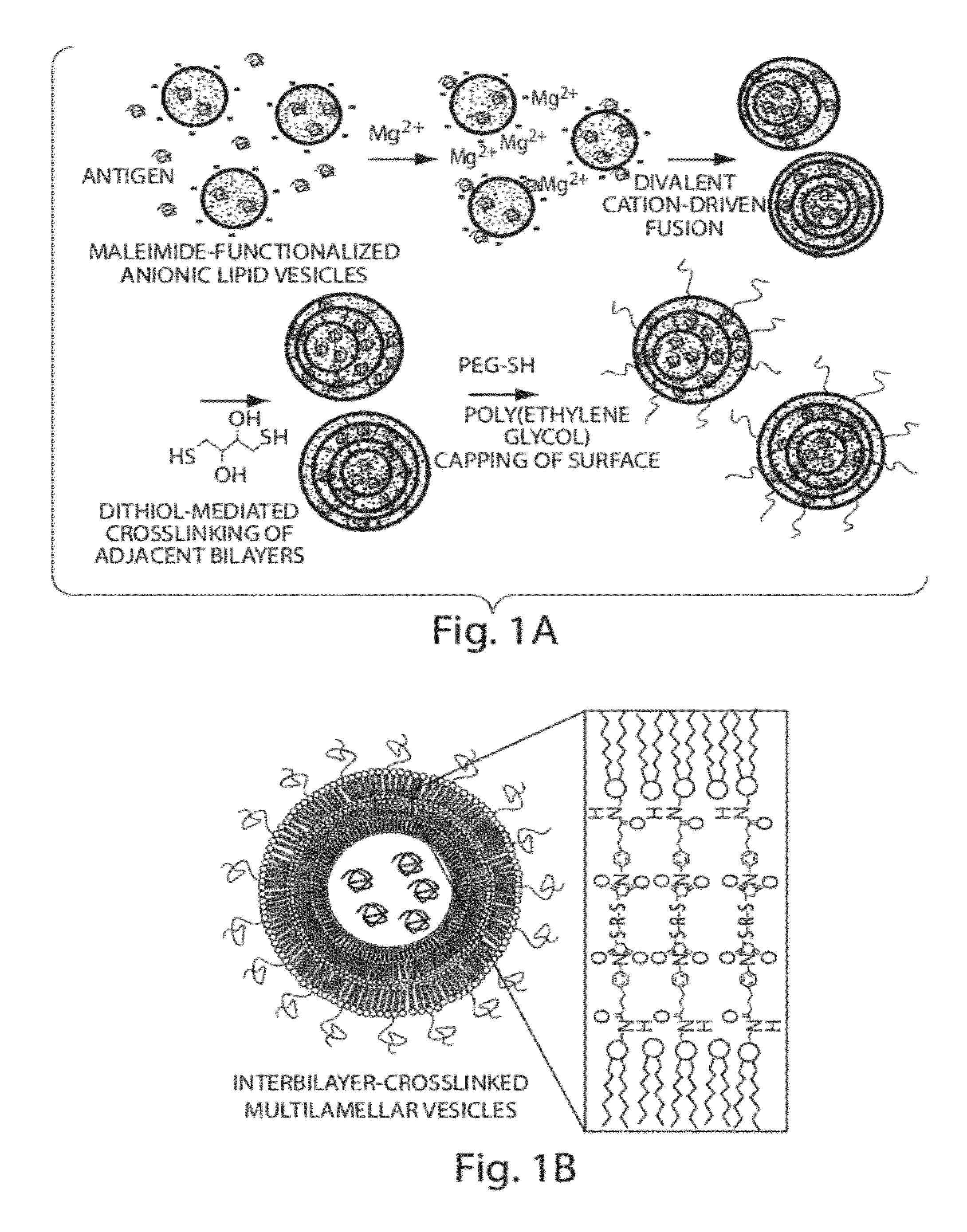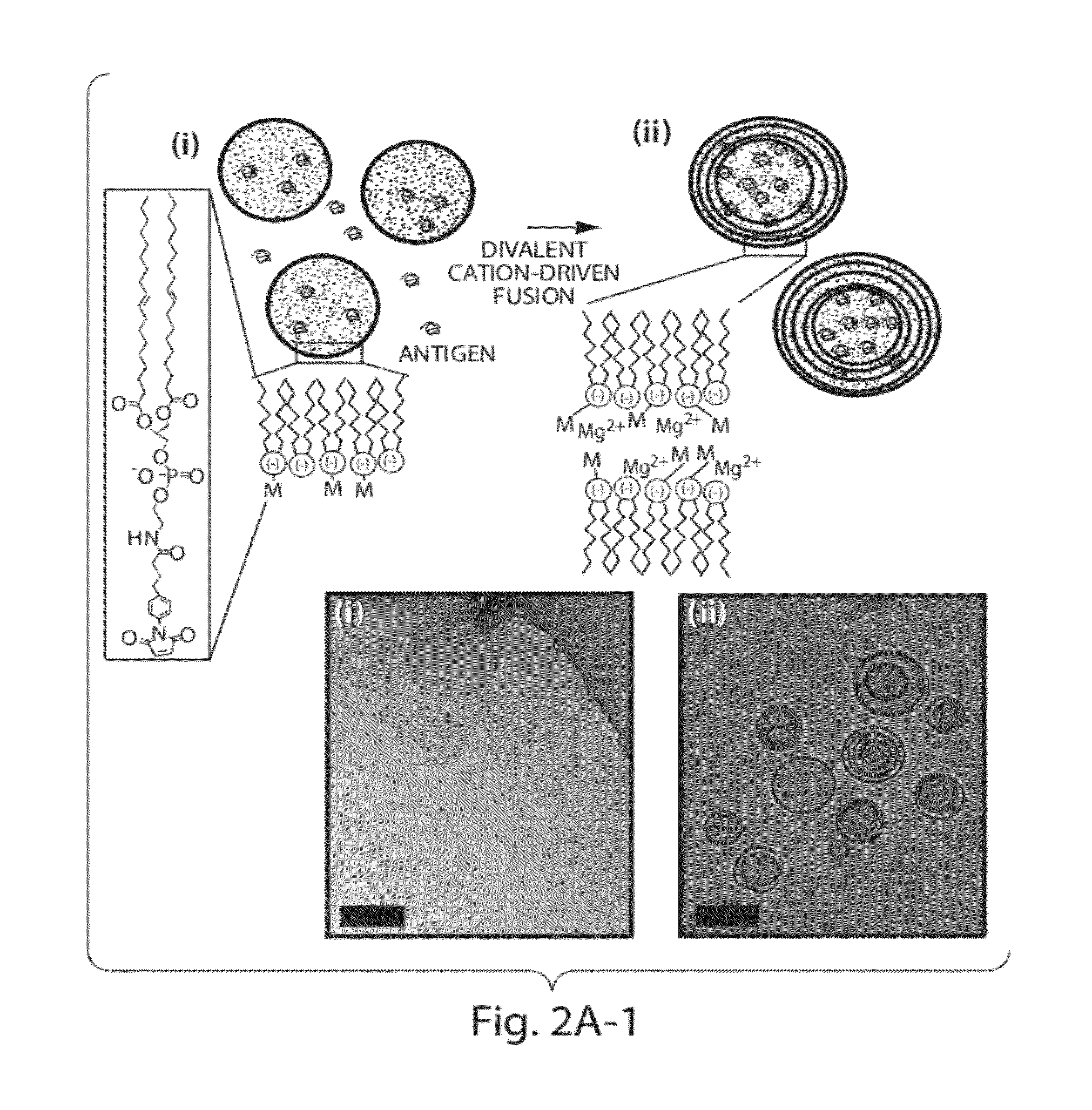Lipid vesicle compositions and methods of use
a technology of lipid vesicle and composition, which is applied in the direction of drug composition, enzymology, viruses, etc., can solve the problems of difficult to achieve high encapsulation of many macromolecular drugs within liposomes, and the destruction of therapeutics, so as to achieve high hydrophobicity, prolong release profiles, and increase loading capacity
- Summary
- Abstract
- Description
- Claims
- Application Information
AI Technical Summary
Benefits of technology
Problems solved by technology
Method used
Image
Examples
example 1
[0208]To address limitations in prior art methods, we envisioned the synthesis of lipid particles stabilized by forming crosslinks connecting the headgroups of adjacent lipid layers within multilamellar vesicles (MLVs). Divalent cations are known to induce fusion of liposomes into MLVs. (See Duzgunes et al., J Membrane Biol. 1981; 59:115-125.) We modified this process by introducing maleimide-functionalized lipids (e.g., MPB) into vesicles and crosslinking layers of MPB using dithiol-crosslinkers (e.g., synthesis schematics shown in FIG. 1A). The resulting interbilayer-crosslinked multilamellar lipid vesicles (ICMVs) exhibited attractive features, such as greatly enhanced protein encapsulation efficiency (100-fold relative to simple liposomes, FIG. 5), protein loading per mass of particles (20-fold relative to simple liposomes, FIG. 5), and sustained retention of entrapped cargos in the presence of serum with slow, sustained release kinetics (FIG. 6). The synthesis is carried entire...
example 2
[0218]The following Example is a more comprehensive description and reporting of some of the experiments and results described in Example 1.
[0219]Currently licensed vaccine adjuvants (e.g., aluminum hydroxide and the oil-in-water emulsion MF59) promote immunity by primarily eliciting humoral immune responses, without stimulating cellular immunity1,2. As strong CD8+ T cell (CD8T) responses may be required for vaccines against cancer or intracellular pathogens such as HIV, malaria, and hepatitis C, there is great interest in technologies to promote concerted humoral and cellular immune responses3,4. To this end, engineered live vaccine vectors such as non-replicating recombinant viruses have been developed5-7, which can induce both robust antibody responses and massive expansion of functional antigen-specific CD8+ T-cells in murine models. However, safety concerns with live vectors and anti-vector immunity can complicate live vector vaccine design7. Pre-existing vector-specific immune...
example 3
[0237]In this Example, we studied the immune response elicited by nanoparticles composed of ICMV carrying recombinant VMP both entrapped in the aqueous core and anchored to the lipid bilayer surfaces. Immunization with these particles and MPLA promoted high-titer, high-avidity antibody responses against VMP, lasting more than 1 year in mice at 10-fold lower doses than conventional adjuvants. Compared to soluble VMP mixed with MPLA, VMP-ICMVs promoted broader humoral responses, targeting multiple epitopes of the protein and a more balanced Th1 / Th2 cytokine profile from antigen-specific T-cells. We also examined components of the B-cell response and found that ICMVs promoted robust germinal center (GC) formation at low doses of antigen where no GC induction occurred with soluble protein immunization, and that GCs nucleated near depots of ICMVs accumulating in the draining lymph nodes over time. In parallel, ICMV vaccination enhanced the expansion of antigen-specific follicular helper ...
PUM
| Property | Measurement | Unit |
|---|---|---|
| hydrodynamic diameter | aaaaa | aaaaa |
| concentrations | aaaaa | aaaaa |
| diameter | aaaaa | aaaaa |
Abstract
Description
Claims
Application Information
 Login to View More
Login to View More - R&D
- Intellectual Property
- Life Sciences
- Materials
- Tech Scout
- Unparalleled Data Quality
- Higher Quality Content
- 60% Fewer Hallucinations
Browse by: Latest US Patents, China's latest patents, Technical Efficacy Thesaurus, Application Domain, Technology Topic, Popular Technical Reports.
© 2025 PatSnap. All rights reserved.Legal|Privacy policy|Modern Slavery Act Transparency Statement|Sitemap|About US| Contact US: help@patsnap.com



